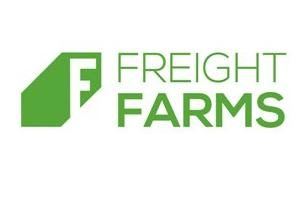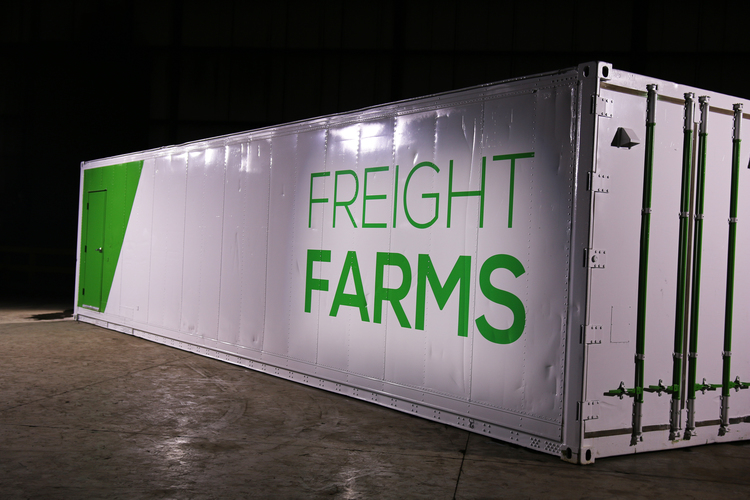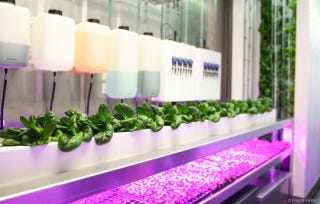Vertical Urban Farming: The Food Supply’s Savior from Climate Change?

Will new startups focused on high density urban farms save us from increasing prices and the environmental impacts of increasing farmland conversion?
Climate change, broadly referring to the increased concentration of CO2 in the atmosphere and resulting increase in temperatures is expected to have significant negative impact on global agriculture, by way of decreasing yields, loss of farmland and labor and capital displacements[1]. As global population grows, agriculture itself is expected to drive an increasing share of CO2 emissions from its current ~33%[2]. As more of the global population shifts to urban areas[3], harvest, storage and delivery to consumers will grow costlier, resulting in a significant rise in expected food prices[4].
Startup to the Rescue?

One of the firms grabbling with this threat is Freight Farms, a Boston based start-up. Freight Farm’s principal product is the “Leafy-Green-Machine” a converted freight container, outfitted with an LED-lit hydroponic growing system, capable of producing vegetables, herbs and edible greens year-round[5]. With less than 10% of the water requirements of traditional agriculture, and a fully-controllable nutrient content, crop yields can reach commercial sustainability within a few months with production equivalent to 2 acres of farmland[6].
The principal way that Freight Farms will alleviate the impact of climate change is the shortening of the supply chain, where agriculture can be decentralized to be closer to consumers, eliminating transportation and storage. Without increased farmland, it not only makes more efficient use of resources, but could also potentially slow the impact of climate change (e.g. regrowth of forests or waterways currently diverted for agriculture[7]).

Short-Term & Medium-Term Issues
In the short run, Freight Farms products crucially rely on the significant price premium commanded by organic, locally sourced produce to be economically viable, and are therefore only attractive in large metropolitan areas[8]. Furthermore, as global CO2 concentrations rise, crop yields may in fact get better before they get worse (due to the impact of CO2 fertilization[9]). The company has responded by focusing on extensive data collection, aiding in research and helping to alleviate future yield losses.
In the medium to long run, adoption depends on matching of production with demand on a local level, and the right local context of utility costs, food demand and alternative food supply. Water-locked locations with correspondingly high transportation costs will obviously be more attractive than those with relatively easier access to fresh produce. As technology, especially LED operating costs, continues to improve, the attractiveness of these solutions will also increase.
Challenges to Widespread Adoption
The current payback period of approximately 3 years (after labor, rent & utilities) could still be significantly improved. With required labor of 20-30 man-hours per week to maintain, average income per unit is below developed market wage rates[10] – a significant barrier to adoption in metropolitan areas.
Despite the reductions in transportation and harvesting costs, the Freight Farm product is a thermodynamic nightmare; instead of energy from the ultimate renewable resource (i.e. sunlight), the energy for running the farm comes from grid power (~100 kWh per day)[11]. The resulting carbon footprint swamps the reduction in carbon emission from transportation, and even if the energy were to come from solar, today’s technology requires 125 standard 100-Watt panels[12]. While one might argue that the reduction in arable land offsets this, it’s clear that today, traditional farming has cost advantage at large scale.
Remaining Questions
There are many factors that could shift the adoption of vertical urban farming from niche-applications like farm-to-table restaurants in New York, to larger scales. Will large-scale farming eventually move indoors entirely? What is the role of the niche applications of today – will these continue to expand and displace traditional farming, or are they just a way to bring awareness of sustainable food production to the masses? (795 words)
~~~~~~~~~~~~~~~~~~~~~~~~~~~~~~~~~~~~~~~~~~~~~~~~~~~~~~~~~~~~~~~~~~~~~~~~~~~~~~~~~~~~~~~~~~~~~~~~~~~~~
[1] Giannini TC, Costa WF, Cordeiro GD, Imperatriz-Fonseca VL, Saraiva AM, Biesmeijer J, et al. (2017) Projected climate change threatens pollinators and crop production in Brazil. PLoS ONE12(8): e0182274. https://doi.org/10.1371/journal.pone.0182274
[2] Natasha Gilbert, “One-third of our greenhouse gas emissions come from agriculture” Nature 10.1038/nature.2012.11708 https://www.nature.com/news/one-third-of-our-greenhouse-gas-emissions-come-from-agriculture-1.11708
[3] World Health Organization, Global Health Observatory Data 2014; Accessed November 2017. http://www.who.int/gho/urban_health/situation_trends/urban_population_growth_text/en/
[4] George Martin, Roland Clift and Ian Christie, “Urban Cultivation and Its Contributions to
Sustainability: Nibbles of Food but Oodles of Social Capital” Sustainability 2016, 8(5), 409. http://www.mdpi.com/2071-1050/8/5/409/htm
[5] Freight Farms, “Frequently Asked Questions,” https://www.freightfarms.com/faq/, Accessed November 2017
[6] Freight Farms, “How the LGM Stacks-up,” https://www.freightfarms.com/blog/data-from-our-growers-how-the-lgm-stacks-up, Accessed November 2017
[7] Alice Sweitzer, “Freight Farms Builds Farms in Shipping Containers, and NASA Wants to Launch Them to Space” http://www.popularmechanics.com/science/green-tech/a27200/freight-farms-shipping-containers-nasa-launch-space/
[8] Square Roots, “Our Purpose” https://squarerootsgrow.com/, Accessed November 2017
[9] Miodrag Stevanović et al, “The impact of high-end climate change on agricultural welfare,” Science Advances 24 Aug 2016: Vol. 2, no. 8, e1501452 http://advances.sciencemag.org/content/2/8/e1501452.full
[10] Freight Farms, “Income Projections,” https://www.freightfarms.com/income-projection#proforma-body, Accessed November 2017
[11] Freight Farms, “Frequently Asked Questions,” https://www.freightfarms.com/faq/, Accessed November 2017
[12] Assumes 8 hours per day of full capacity sunlight; standard 100-Watt panel as sold by Home Depot, https://www.homedepot.com/p/Grape-Solar-100-Watt-Polycrystalline-Solar-Panel-for-RV-s-Boats-and-12-Volt-Systems-GS-Star-100W/204211365?cm_mmc=Shopping%7cTHD%7cG%7c0%7cG-VF-PLA-D27E-Electrical%7c&gclid=CjwKCAiAxarQBRAmEiwA6YcGKLYL-buJaP558ulT8oJzuMlkivR7djJh7oqUf-uNADqE535Tvge6qBoCYQcQAvD_BwE&gclsrc=aw.ds&dclid=CNrozJH7vtcCFZOpyAodb0gD1w



This article provides a great overview of some of the opportunities and challenges of vertical farming. The positive impact of reducing ‘food miles’ may turn out to be slightly overstated, based on some studies which suggest that food transportation to urban centers is a relatively small component of the environmental impact of food production. However, I agree that tight control of input resources such as water should help improve sustainability and cost efficiency (if the energy costs can be brought down!). It is also interesting to think of the additional benefits from vertical farming – it is by nature much more insulated from extreme or sub-optimal weather conditions (another impact of climate change) and therefore may provide more food security, and by growing in sterile conditions the use of pesticides etc. may be reduced.
Thanks for your perceptive analysis of Freight Farms. You are right to point out the questionable savings in energy production, weighing off transportation savings with higher utility consumption. There are, however, several other benefits unrelated to climate change: all-seasonal farming to drive year-round productivity, less spoilage through transport & refrigeration, lower pesticides use / exposure to infectious disease, and higher quality. Aside from the novelty, the greens typically sell for a significant premium to restaurants because they are both fresher and more unique; since the growing environment is controlled, growers are able to tinker with color, taste, texture etc. [Farm One, for example, is a vertical growing startup in New York selling their produce same-day to high-end restaurants]. Lastly, to your question about scaling production, Plenty, a company promising warehouse-sized indoor vertical farming raised $200M from Bezos, Softbank and other investors in July. Will be interesting to see if they can drive down costs!
Although the concept of indoor farming seems unnatural and something from a distant future, large-scale use of indoor farming might prove to be not only more sustainable but also the only means by which the world will be able to feed its growing population.
As the environment changes, it is not only getting hotter, but it is getting more unpredictable. The same region can be affected by extreme heat followed by extreme cold [1]. Growing crops will become increasingly difficult in such an environment, even in regions that are not characterized by drought or extreme cold. As world population grows, it will put pressure on land resources and prices, which will be driven higher by lower supply and higher demand.
Indoor farming has the potential to alleviate some of the problems on the food supply chain caused by climate change and growing population. Indoor farming provides a controlled environment, which can produce more crops per a given space than traditional farming. This will help alleviate the supply shortages in the food supply chain and expand the regions of the world where we can grow food. Indoor farming can also be set up near cities, in varying size facilities. This will allow produce to be grown closer to its end customer, reducing transportion cost and well as food waste. A reduction of food waste can lead to more supply availability for supply starved areas of the world as well as lower prices/overall spend for end customers as produce will reach customers much sooner leading to longer shelf life once purchased.
[1] https://www.livescience.com/37363-how-predict-weather.html